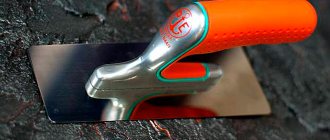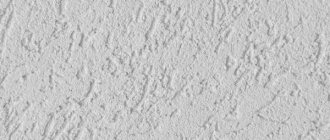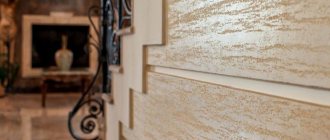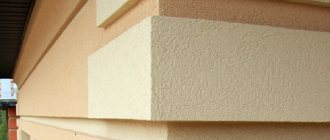Decorative plaster mortar is becoming increasingly popular, this is due to the possibility of obtaining a variety of effects on the surface and a wide palette of colors. But to carry out plastering, it is advisable to use a special tool - a trowel for decorative plaster. The features of the device, operating rules and selection will be discussed in detail below.
What is a trowel for plaster
What is a trowel for plaster, not all novice craftsmen understand what the tool is. This name is taken from the German version; in Russian the device is called a trowel. The plastering trowel is used frequently, but is also used to spread other types of mortar.
This makes it convenient to collect the required amount of solution and then transfer it to a spatula. A smooth edge area does a good job of removing excess mortar from the wall. The flat side serves to level the mortar layer. The tool can cope with troweling work, as well as make the required relief on the plaster base.
The plastering trowel is used frequently, but is also used to spread other types of mortar.
What are its varieties?
The trowel comes in a variety of shapes to suit different types of work. To choose the right option, you need to understand the differences between them. The following types of tools are distinguished:
- A mason's trowel, a spatula made in the shape of a trapezoid, intended for laying bricks and stones;
- Finisher's tool, suitable for stirring the solution, serves as a measuring device for the mixture. They apply a solution based on gypsum and cement;
- A concrete trowel, in the shape of a triangle, can measure the mixture and mix the mortar, used for laying bricks;
- Tile type, made in the form of a trapezoid with cut ends or drops. Used for tile material and measuring ingredients;
- Plastering trowel, used to spread material onto the surface, leveling the layer;
- Trowel for decorative plaster and grout. It stands out for its ability to smooth out the layer and distribute it in the desired shape over the base;
- Toothed, selected for working with tile adhesive, and also serves as a trowel. The serrated side can be used to make the necessary grooves during laying;
- Corner version, designed for processing corner areas, there are types for external and internal corners;
- The jointing trowel has a narrow working side, which is necessary for working with seams between bricks;
- For filling seams, it is convenient to use with the previous type. The tool has a wide side where the solution is located, and there are also convenient parts for working vertically and horizontally;
- A device for working with aerated concrete blocks helps to evenly distribute the solution over the surface, immediately collect the required amount of product and level the layer.
The working side is usually made of high-quality metal material in order to cope with stirring the solution and collecting the required amount. The handle can be made with a rubber coating, this helps to prevent the tool from slipping while processing the surface.
A plastering trowel is used to spread material onto the surface, leveling the layer.
Rules for using products
The length of the blade ranges from 75 to 100 millimeters . The shorter length is well used for jointing vertical joints in masonry.
The corner trowel is used to level the corner parts of walls when plastering. Corner devices are available for sale for decorating internal and external corners of walls; such a universal device is used to create internal and external corners.
The seam-filling trowel is convenient to use together with a jointing trowel. Such a tool can hold a supply of grout due to its wide surface. In addition, for more accurate dusting of joints with grout, there is a raised side along the edge of the working plane, and for working with vertical joints, a slit-like window with a total width of 10 millimeters on the rear wall is best suited.
Tool for applying glue to aerated concrete blocks . The advantage of such a tool is undeniable, since it performs several functions at once - applying the required amount of mixture in one step, uniform application in one movement, as well as high-quality leveling, giving the desired relief to the applied layer with the comb side of the device. Such a product is created in different sizes, but the most convenient and at the same time in demand is considered to be one with a width of 100 to 140 millimeters.
The blades of such construction tools are created from a hard, inflexible sheet with a total thickness of 1.5/2 millimeters, since many of them are designed for mixing and lifting the solution. A well-made tool is easy and simple to work with, as it fits well in the palm of your hand, is relatively light in weight and is designed for long-term use.
When buying a trowel, you should definitely try it in your hand and make sure that there are no extra protrusions, nicks or burrs on the handle that will not allow it to work normally, and can also injure the skin or rub several calluses. The trowel should fit well in the hand, that is, it should be balanced and comfortable for long-term use. Trowels that have an additional pad on the handle are especially in demand. This addition helps the product slip in the hand - the handle will fit well into the palm without causing any calluses.
When purchasing such a seemingly simple tool, you need to be careful and attentive. You don’t need to immediately look only at the cheapest device - you can buy a low-quality blade that bends during operation and quickly becomes covered with a coating of corrosion. In some cases, you can purchase a spatula with a very uncomfortable handle, which will not allow you to work normally when performing labor-intensive plastering operations.
Features of trowels for decorative plaster
The Venetian trowel should be selected taking into account the shape and materials from which it is made. It is ideal for working with Venetian plaster; it allows you to distribute the solution correctly, which is especially important when repairs are carried out yourself.
The shape of the working side can be varied, it affects the convenience of distributing different compositions, and is selected for the type of work.
The material used to make the tool is also very important, because the strength and finishing result depend on it. The optimal option is stainless steel with a thickness of 1.5 to 2 mm. If the base is weak and the base is deflected, the collection and distribution of the solution will be uncomfortable.
The handle is usually made of plastic or wood. The materials are lightweight, which is convenient for the craftsman. It is also desirable to have a rubberized handle so that the tool does not slip and calluses do not form on the hands.
Before purchasing, you should evaluate the convenience of the tool; the handle must be suitable for the master. And the weight of the trowel should not be significant. There is a plastic trowel for decorative plaster, it is lightweight, and a special plastic is used, which is reliable.
The optimal option is stainless steel with a thickness of 1.5 to 2 mm.
Choosing a trowel for working with decorative types of plaster
A trowel for Venetian plaster is selected primarily based on how comfortable it fits in the hand, as well as the correct purpose of the device. But there are still other parameters.
A trowel for Venetian plaster is selected primarily based on how comfortable it fits in the hand.
What to pay attention to, basic criteria
Professionals note the following criteria that it is advisable to take into account when choosing a device for work:
- Lightness of the trowel;
- The working part should be smooth and mirror-like;
- The standard shape is made in the form of a rectangle;
- Narrow options are more practical;
- A plate that is too long can cause difficulties during operation; it must be optimally combined with the length of the handle.
The working part should be smooth and mirror-like.
How to choose a color
When adding bright colors to Venetian plaster, you must remember that with each stage of drying the color will change and in the end the result may not be what was planned.
Before you begin, you need to seal the upper edges of the walls with masking tape, which is removed immediately after completing the work. You cannot wait until the Venetian putty has completely dried to avoid the appearance of cracks and chips when removing it from the wall.
If the putty mass is colorless, it is necessary to mix color into it. Add enough paint to achieve the desired shade. It is important to pay attention to the fact that in the finished version, Venetian putty indoors looks a little brighter and darker than on the sample presented in the catalog.
Masters advise not to use very bright shades, suggesting sticking to pastel tones. It is advisable to use all materials from the same company (plaster and color) so that their properties are compatible with each other.
How does a Venetian trowel differ from a regular one?
The name Venetian does not mean that it is made in Venice or is only suitable for distributing this type of plaster. It can also be used for other solutions.
It differs from standard trowels in that it is made of high-quality stainless steel, which is also polished. The corner areas are rounded and the blade edge is chamfered.
It differs from standard trowels in that it is made of high-quality stainless steel, which is also polished.
Sizes and shapes of Venetian trowels
A trowel is required to distribute compositions with the smallest fractions. The handle is installed in the middle of the rectangle so that the plate is pressed evenly to the surface. The metal material should not blacken the surface, so it must be of high quality. Typically the plate size is 20x8 or 24x10. But there is also a 28x12 option.
The metal material should not blacken the surface, so it must be of high quality.
Technology of applying plaster using a trowel
You need to apply the layer correctly, otherwise you won’t get the desired result. Only from the outside, it seems that the process is easy, but some skills are still needed, you should practice:
- Spray, do not leave a distance between the sprays, they should be approximately 3-5 mm thick;
- Primer, a thicker composition is applied, you need to obtain a significant thickness of 7 mm, you can throw on or spread the primer composition;
- Throwing the solution, move from left to right or vice versa, but not from top to bottom;
- Using a trowel, part of the plaster is removed so that the layer becomes even;
- Covering, the layer will be made thin at 2 mm, a more liquid solution is used;
- The corners are leveled using corner material.
Using a trowel, part of the plaster is removed so that the layer becomes even.
Getting shine
Wax is used for finishing to make the plaster waterproof and increase its shine. Wax polishing can be carried out approximately a week after the final application of all finishing coats. It is worth noting that there is not only a simple transparent composition that is most often used. But you can also use other compositions that have an additional effect, which will allow you to obtain pearlescent, gold or silver veins.
Liquid wax is applied using a specialized wax glove. Next, you need to grind with a grinding machine using a nap type attachment.
Tool manufacturers and pricing policy
There are many similar devices on the market, but there are top sellers that are of high quality. There are several brands: Oikos, CO.ME, PQtools, Pavan, Senideco, Storch.
As for the pricing policy, you need to understand that the high-quality materials used increase the cost of the instrument. The most expensive types can cost about 3,000, the average price is more than 1,000 rubles.
There are many similar devices on the market, but there is a leader in sales.
A trowel for plastering work allows you to perform finishing more comfortably and get the desired beautiful result. When choosing, it is important to know the purpose of the trowel and evaluate the comfort of its use for the master himself.










